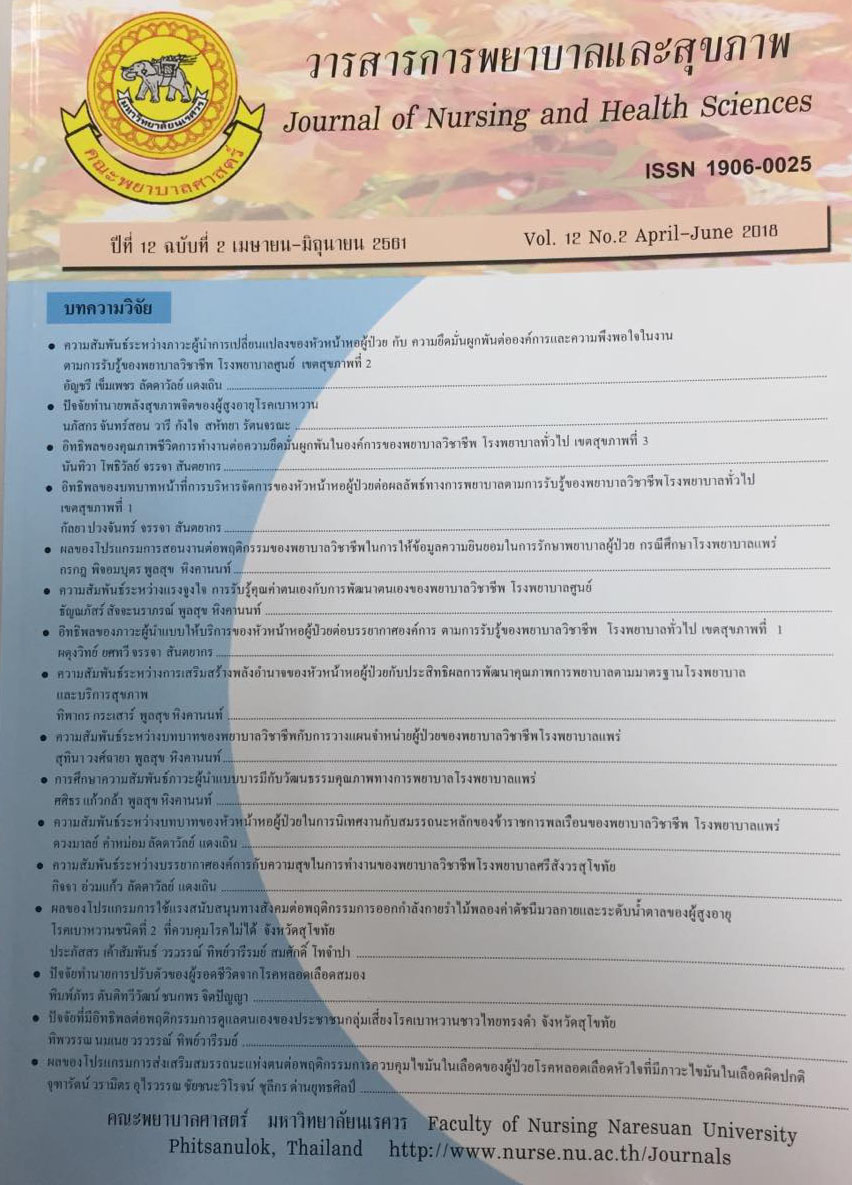ปัจจัยทำนายการปรับตัวของผู้รอดชีวิตจากโรคหลอดเลือดสมอง
Main Article Content
บทคัดย่อ
การวิจัยการวิจัยครั้งนี้เป็นการวิจัยเชิงสำรวจ มีวัตถุประสงค์เพื่อ ศึกษาการปรับตัวของผู้รอดชีวิตจากโรค หลอดเลือดสมอง และอำนาจในการทำนายของปัจจัยคัดสรร ได้แก่ การสนับสนุนทางสังคม การเผชิญ ความเครียด ความรู้สึกไม่แน่นอนในความเจ็บป่วย ความรุนแรงของอาการ และความสามารถในการรู้คิด โดยใช้แนวคิดความรู้สึกไม่แน่นอนในความเจ็บป่วยของ Mishel (1988) เป็นกรอบแนวคิดในการวิจัย กลุ่มตัวอย่างคือ ผู้รอดชีวิตจากโรคหลอดเลือดสมองวัยผู้ใหญ่ที่มาติดตามอาการที่โรงพยาบาลมหาวิทยาลัย นเรศวร และโรงพยาบาลพุทธชินราช จำนวน 110 คน เลือกกลุ่มตัวอย่างโดยวิธีการสุ่มอย่างง่าย เครื่องมือ ที่ใช้ในการวิจัย คือ แบบบันทึกข้อมูลทั่วไป แบบสอบถามการปรับตัว (Psychosocial Adjustment to Illness Scale) แบบประเมินการสนับสนุนทางสังคม (ENRICH Social Support Questionnaire) แบบประเมิน การเผชิญความเครียด (Jaloweic coping questionnaire) แบบประเมินความรู้สึกไม่แน่นอนในความเจ็บป่วย (The Mishel Uncertainty in Illness Scale-Community Form) แบบประเมินความรุนแรงของอาการ (National Institute of Heath Stroke Scale) และแบบประเมินความสามารถในการรู้คิด (MMSE-Thai) ค่าความเที่ยงของเครื่องมือแบบสอบถามการปรับตัว แบบประเมินการสนับสนุนทางสังคม แบบประเมิน การเผชิญความเครียด แบบประเมินความรู้สึกไม่แน่นอนในความเจ็บป่วย เท่ากับ .95, .91, .86 และ .90 ตามลำดับ วิเคราะห์ข้อมูลโดยการหาค่าเฉลี่ย ส่วนเบี่ยงเบนมาตรฐาน สัมประสิทธิ์สหสัมพันธ์ของเพียร์สัน และสถิติการถดถอยพหุคูณแบบเป็นขั้นตอน ผลการวิจัยสรุปได้ ดังนี้ 1. การปรับตัวของผู้รอดชีวิตจากโรคหลอดเลือดสมอง มีค่าเฉลี่ยอยู่ในระดับดี (ค่าเฉลี่ย = 2.51, SD = .48) 2. การสนับสนุนทางสังคมสามารถทำนายการปรับตัวของผู้รอดชีวิตจากโรคหลอดเลือดสมองได้ร้อยละ 9.5 (Adjusted R2 = .095)
Article Details
เอกสารอ้างอิง
การคัดกรอง/ประเมินผู้สูงอายุ. พิมพ์ครั้งที่ 1.
กรุงเทพฯ : สำนักงานกิจการโรงพิมพ์สงเคราะห์
องค์การทหารผ่านศึก.
กองพยาบาลสาธารณสุข สำนักอนามัย. (2554). การดูแล
ผู้ป่วยโรคหลอดเลือดสมองที่บ้านสำหรับ
บุคลากรสาธารณสุข ปีงบประมาณ 2554.
กรุงเทพฯ : กระทรวงสาธารณสุข.
กฤษณา พิรเวช. (2552). การดูแลรักษาภาวะสมอง
ขาดเลือดในระยะเฉียบพลัน. กรุงเทพฯ : โรงพิมพ์
แห่งจุฬาลงกรณ์มหาวิทยาลัย.
กวินทร์นาฏ บุญชู. (2554). ประสบการณ์การเป็น
ผู้ป่วยโรคหลอดเลือดสมองรายใหม่ระยะ
เฉียบพลัน. วิทยานิพนธ์ปริญญามหาบัณฑิต
สาขาการพยาบาลผู้ใหญ่ คณะพยาบาลศาสตร์
มหาวิทยาลัย บูรพา.
กาญจนา ศิริวราศัย. (2536). ความสัมพันธ์ระหว่าง
สัมพันธภาพในครอบครัว ความหวังกับการปรับตัว
ในผู้ป่วยอัมพาตครึ่งซีก. วิทยานิพนธ์ปริญญา
มหาบัณฑิต สาขาวิชาพยาบาลศาสตร์ บัณฑิต
วิทยาลัย มหาวิทยาลัยมหิดล.
จันทนา หล่อตจะกูล. (2549). การพัฒนาเครื่องมือวัด
คุณภาพชีวิตของผู้ป่วยไทยโรคกล้ามเนื้อหัวใจ
ขาดเลือด. วิทยานิพนธ์ปริญญาดุษฎีบัณฑิต
สาขาวิชาพยาบาลศาสตร์ คณะพยาบาลศาสตร์
จุฬาลงกรณ์มหาวิทยาลัย.
ประภัสสร สมศรี. (2549). ผลของการสร้างพลังอำนาจ
ต่อการปรับตัวของผู้ป่วยอัมพาตครึ่งซีก.
วิทยานิพนธ์ปริญญามหาบัณฑิต สาขาวิชาการ
พยาบาลผู้ใหญ่ บัณฑิตวิทยาลัย มหาวิทยาลัย
ขอนแก่น.
ปราณี มิ่งขวัญ. (2542). ความเครียดและการเผชิญ
ความเครียดในผู้สูงอายุโรคหลอดเลือดสมอง.
วิทยานิพนธ์ปริญญามหาบัณฑิต สาขาวิชา
การพยาบาลอายุรศาสตร์และศัลยศาสตร์
บัณฑิตวิทยาลัย มหาวิทยาลัยเชียงใหม่.
ยงชัย นีละนนท์, สุชีรา ภัทรายุตวรรตน์, พิพัฒน์
เชี่ยววิทย์, สงคราม โชติกอนุชิต, จุลจักร
ลิ่มศรีวิไล, ลัลธริตา เจริญพงษ์, ... นิพนธ์
พวงวารินทร์. (2553). การศึกษาความเที่ยงตรง
ของแบบวัดความรุนแรงโรคหลอดเลือดสมอง
National Institute of Health Stroke Scale
ภาคภาษาไทย (NIHSS-T). จดหมายเหตุ
ทางแพทย์ แพทยสมาคมแห่งประเทศไทยใน
พระบรมราชูปถัมภ์ 93(1) : 171-178.
ยุพาพร โอฬาริกพันธ์. (2541). กลุ่มประคับประคอง
ต่อการปรับตัวของผู้ป่วยสโตร็ค. วิทยานิพนธ์
ปริญญามหาบัณฑิต สาขาวิชาการพยาบาล
ผู้ใหญ่ บัณฑิตวิทยาลัย มหาวิทยาลัยขอนแก่น.
รจน์ เพ็งแก้ว. (2551). การปรับตัวในการฟื้นสภาพ
ของผู้ป่วยโรคหลอดเลือดสมอง โรงพยาบาล
พระจอมเกล้า จังหวัดเพชรบุรี. วิทยานิพนธ์
ปริญญามหาบัณฑิต สาขาการพยาบาลผู้ใหญ่
ขั้นสูง บัณฑิตวิทยาลัย มหาวิทยาลัยคริสเตียน.
วราลักษณ์ ทองใบปราสาท. (2550). ประสบการณ์
การปรับตัวต่อการเจ็บป่วยของผู้ป่วยโรค
หลอดเลือดสมองที่อาศัยในตำบลแสนตอ
อำเภอขาณุวรลักษบุรี จังหวัดกำแพงเพชร.
วิทยานิพนธ์ปริญญามหาบัณฑิต สาขาวิชา
การพยาบาลเวชปฏิบัติชุมชน บัณฑิตวิทยาลัย
มหาวิทยาลัยนเรศวร.
วีณา ลิ้มสกุล. (2545). ผลของโปรแกรมการสนับสนุน
ของครอบครัวต่อการปรับตัวของผู้สูงอายุ
โรคหลอดเลือดสมอง. วิทยานิพนธ์ปริญญา
มหาบัณฑิต สาขาวิชาการพยาบาลผู้สูงอายุ
บัณฑิตวิทยาลัย มหาวิทยาลัยเชียงใหม่.
สำนักงานวิจัยเพื่อการพัฒนาหลักประกันสุขภาพไทย.
(2557). รายงานฉบับสมบูรณ์ การศึกษาความ
แตกต่างระหว่างสิทธิสวัสดิการรักษาพยาบาล
ของบริการโรคหลอดเลือดสมองและผลลัพธ์ :
การศึกษาเชิงปริมาณ. กรุงเทพฯ : กระทรวง
สาธารณสุข.
สำนักโรคไม่ติดต่อ กรมควบคุมโรค กระทรวง
สาธารณสุข. (2557). จำนวนและอัตราตายด้วย
โรคหลอดเลือดสมองใหญ่ ปีพ.ศ. 2554-2555
อัตราต่อแสนประชากร. กรุงเทพฯ : กระทรวง
สาธารณสุข.
สำนักโรคไม่ติดต่อ กรมควบคุมโรค กระทรวง
สาธารณสุข.(2559). รายงานประจำปี 2558.
กรุงเทพฯ : สำนักงานกิจการโรงพิมพ์องค์การ
สงเคราะห์ทหารผ่านศึกในพระบรมราชูปถัมภ์.
สุชาดา กาสีวงศ์. (2545). การปรับตัวของผู้ป่วยสโตร็ค.
วิทยานิพนธ์ปริญญามหาบัณฑิต สาขาวิชา
การพยาบาลผู้ใหญ่ บัณฑิตวิทยาลัย มหาวิทยาลัย
ขอนแก่น.
สุภาณี แก้วธำรงค์. (2543). ความรู้สึกไม่แน่นอนในความ
เจ็บป่วยและปัจจัยที่เกี่ยวข้องกับความรู้สึก
ไม่แน่นอนในความเจ็บป่วยของผู้ป่วยโรค
เอส แอ อี. ปริญญาพยาบาลศาสตรมหาบัณฑิต
สาขาวิชาพยาบาลศาสตร์ บัณฑิตวิทยาลัย
มหาวิทยาลัยมหิดล.
สุมาพร บรรณสาร. (2545). ความสัมพันธ์ระหว่างความ
รุนแรงของอาการ ระยะเวลาของการเจ็บป่วย
การสนับสนุนทางสังคม ความรู้สึกไม่แน่นอน
ในความเจ็บป่วย กับการปรับตัวของผู้ป่วยโรค
ไตวายเรื้อรัง. วิทยานิพนธ์ปริญญามหาบัณฑิต
สาขาวิชาพยาบาลศาสตร์ คณะพยาบาลศาสตร์
จุฬาลงกรณ์มหาวิทยาลัย.
สุมาภรณ์ สังขมรรทร. (2549). ปัจจัยคัดสรรที่สัมพันธ์
กับการปรับตัวของผู้สูงอายุโรคเรื้อรัง แผนก
ผู้ป่วยนอก ภาคใต้ตอนบน. วิทยานิพนธ์ปริญญา
มหาบัณฑิต สาขาวิชาพยาบาลศาสตร์ คณะ
พยาบาลศาสตร์ จุฬาลงกรณ์มหาวิทยาลัยมหิดล.
Bertram, M. Y., Katzenellenbogen, J., Vos, T.,
Bradshaw, D., and Hofman, K. J. (2013). The
disability adjusted life years due to stroke in
South Africa in 2008. International Journal of
Stroke 8 : 76-80.
Davis, C. G., Egan, M., Dubouloz, C. J., Kubina, L. A.,
and Kessler, D. (2013). Adaptation following
stroke: a personal projects analysis. Rehability
Psychological 58(3) : 287-298.
Glass, T. A., and Maddox, G. L. (1992). The quality
and quantity of social support: Stroke recovery
as psycho-social transition. Social Science &
Medicine 34(11) : 1249-1261.
Hankey, G. J., Jamrozik, K., Broadhurst, R. J., Forbes,
S., Burvill, P. W., Anderson, C. S., and Stewart-
Wynne, E. G. (2000). Five-year survival after
first-ever stroke and related prognostic factors
in the Perth Community Stroke Study. Stroke
31(9) : 2080-2086.
Mishel, M. H. (1988). Uncertainty in Illness. Image:
the Journal of Nursing Scholarship 20(4) :
225-232.
Murray, C. D., and Harrison, B. (2004). The meaning
and experience of being a stroke survivor:
an interpretative phenomenological analysis.
Disability and Rehabilitation, 26(13), 808-816.
Periard, M. E., and Ames, B. D. (1993). Lifestyle
Changes and Coping Patterns Among
Caregivers of Stroke Survivors. Public Health
Nursing 10(4) : 252-256.
Ragsdale, D., Yarbrough, S., qnd Lasher, A. T. (1993).
Using Social Support Theory to Care for
CVA Patients. Rehabilitation Nursing, 18(3) :
154-161.
Rochette, A. a. b., Tribble, D. S.-C. c. d., Desrosiers, J.
e. f., Bravo, G. f. g., and Bourget, A. f. (2006).
Adaptation and coping following a first stroke:
a qualitative analysis of a phenomenological
orientation. International Journal of Rehabilitation
Research, 29(3): 247-249.
Sj?gren, K., & Fugl-Meyer, A. R. (1982). Adjustment
to life after stroke with special reference
to sexual intercourse and leisure. Journal of
Psychosomatic Research, 26(4), 409-417.
Thorndike, R. M. (1978). Correlation procedures for
research. USA: A Halsted Press Book.
Williams, S., & Murray, C. (2013). The lived experience
of older adults' occupational adaptation
following a stroke. Australian Occupational
Therapy Journal 60(1) : 39-4


